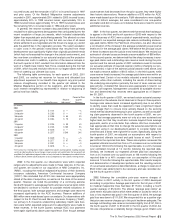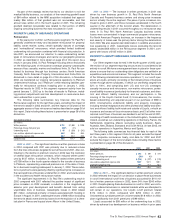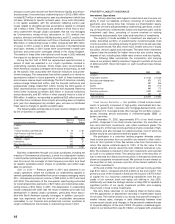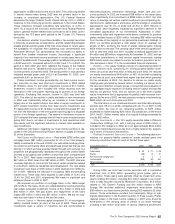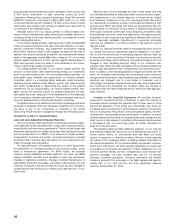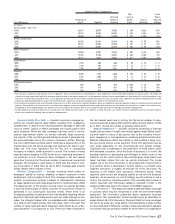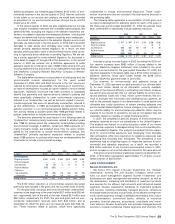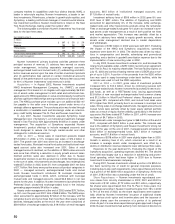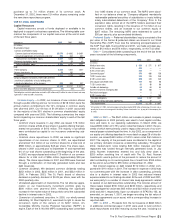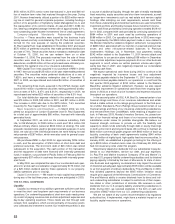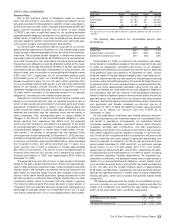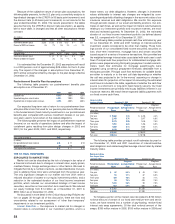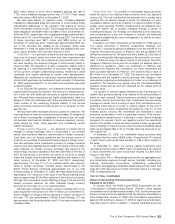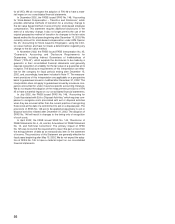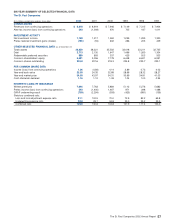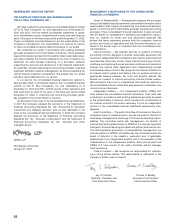Travelers 2002 Annual Report Download - page 51
Download and view the complete annual report
Please find page 51 of the 2002 Travelers annual report below. You can navigate through the pages in the report by either clicking on the pages listed below, or by using the keyword search tool below to find specific information within the annual report.
additional analyses, we released approximately $150 million of envi-
ronmental reserves in the second quarter of 2002. Had we continued
to rely solely on our survival ratio analysis, we would have recorded
no adjustment to our environmental reserves through the six months
ended June 30, 2002.
In the second quarter of 2002, we also supplemented our survival
ratio analysis of asbestos reserves with a detailed claims analysis. We
determined that, excluding the impact of the Western MacArthur set-
tlement, our asbestos reserves were adequate; however, including that
impact, we determined that our asbestos reserves were inadequate.
As a result of developments in the asbestos litigation environment
generally, we determined in the first quarter of 2002 that it would be
desirable to seek earlier and ultimately less costly resolutions of
certain pending asbestos-related litigations. As a result, we have
decided where possible to seek to resolve these matters while contin-
uing to vigorously assert defenses in pending litigations. We are tak-
ing a similar approach to environmental litigations. As discussed in
more detail on pages 27 through 28 of this discussion, in the second
quarter of 2002 we entered into a definitive agreement to settle
asbestos claims for a total gross cost of $995 million arising from any
insuring relationship we and certain of our subsidiaries may have had
with MacArthur Company, Western MacArthur Company or Western
Asbestos Company.
The table below represents a reconciliation of total gross and net
environmental reserve development for the years ended
December 31, 2002, 2001 and 2000. Amounts in the “net” column are
reduced by reinsurance recoverables. The disclosure of environmen-
tal reserve development includes all claims related to environmental
exposures. Additional disclosure has been provided to separately
identify loss payments and reserve amounts related to policies that
were specifically underwritten to cover environmental exposures,
referred to as “Underwritten,” as well as amounts related to environ-
mental exposures that were not specifically underwritten, referred to
as “Not Underwritten.” In 1988, we completed our implementation of a
pollution exclusion in our commercial general liability policies; there-
fore, activity related to accident years after 1988 generally relates to
policies underwritten to include environmental exposures.
The amounts presented for paid losses in the following table as
“Underwritten” include primarily exposures related to accident years
after 1988 for policies which the underwriter contemplated providing
environmental coverage. In addition, certain pre-1988 exposures, pri-
marily first party losses, are included since, they too, were contem-
plated by the underwriter to include environmental coverage. “Not
Underwritten” primarily represents exposures related to accident
years 1988 and prior for policies which were not contemplated by the
underwriter to include environmental coverage.
2002 2001 2000
(In millions) Gross Net Gross Net Gross Net
ENVIRONMENTAL
Beginning reserves $604 $ 519 $684 $ 573 $ 698 $ 599
Reserves acquired ————2710
Incurred losses (2) (3) 6212116
Reserve reduction (150) (150) ————
Paid losses:
Not underwritten (70) (56) (74) (63) (48) (39)
Underwritten (12) (12) (12) (12) (14) (13)
Ending reserves $370 $ 298 $604 $ 519 $ 684 $ 573
The $150 million reduction of environmental reserves discussed
previously was included in the gross and net incurred losses for 2002.
For the year 2000, the gross and net environmental “underwritten”
reserves at the beginning of the year totaled $27 million and $26 mil-
lion, respectively, and at the end of the year totaled $27 million and
$26 million, respectively. For 2001, the year-end gross and net envi-
ronmental “underwritten” reserves were both $28 million, and at
December 31, 2002 the gross and net reserves were both $36 mil-
lion. These reserves relate to policies, which were specifically
underwritten to include environmental exposures. These “under-
written” reserve amounts are included in the total reserve amounts in
the preceding table.
The following table represents a reconciliation of total gross and
net reserve development for asbestos claims for each of the years in
the three-year period ended December 31, 2002. No policies have
been underwritten to specifically include asbestos exposure.
2002 2001 2000
(In millions) Gross Net Gross Net Gross Net
ASBESTOS
Beginning reserves $577 $ 387 $471 $ 315 $ 398 $ 298
Reserves acquired ————5211
Incurred losses 846 482 167 116 72 40
Reserve increase 150 150 ————
Paid losses (328) (241) (61) (44) (51) (34)
Ending reserves $1,245 $ 778 $577 $ 387 $ 471 $ 315
Included in gross incurred losses in 2002 (including the $150 mil-
lion reserve increase) were $995 million of losses related to the
Western MacArthur litigation settlement. Also included in the gross
and net incurred losses for the year ended December 31, 2002, but
reported separately in the above table, was a $150 million increase in
asbestos reserves. Gross paid losses include the $248 million
Western MacArthur payment made in June 2002.
Our reserves for environmental and asbestos losses at
December 31, 2002 represent our best estimate of our ultimate liabil-
ity for such losses, based on all information currently available.
Because of the inherent difficulty in estimating such losses, however,
we cannot give assurances that our ultimate liability for environmen-
tal and asbestos losses will, in fact, match current reserves. We con-
tinue to evaluate new information and developing loss patterns, as
well as the potential impact of our determination to seek earlier and
ultimately less costly resolutions of certain pending asbestos and
environmental related litigations. Future changes in our estimates of
our ultimate liability for environmental and asbestos claims may be
material to our results of operations, but we do not believe they will
materially impact our liquidity or overall financial position.
In 2001, we completed a periodic analysis of environmental and
asbestos reserves at one of our subsidiaries in the United Kingdom.
The analysis was based on a policy-by-policy review of our known
and unknown exposure to damages arising from environmental pollu-
tion and asbestos litigation. The analysis concluded that loss experi-
ence for environmental exposures was developing more favorably
than anticipated, while loss experience for asbestos exposures was
developing less favorably than anticipated. The divergence in loss
experience had an offsetting impact on respective reserves for envi-
ronmental and asbestos exposures; as a result, we recorded a
$48 million reduction in net incurred environmental losses in 2001,
and an increase in net incurred asbestos losses for the same amount.
Total gross environmental and asbestos reserves at December 31,
2002, of $1.6 billion represented approximately 7% of gross consoli-
dated reserves of $22.6 billion.
ASSET MANAGEMENT
Nuveen Investments, Inc.
We hold a 79% interest in Nuveen Investments, Inc. (“Nuveen
Investments,” formerly The John Nuveen Company), which consti-
tutes our asset management segment. Nuveen Investments’ core
businesses are asset management and related research, as well as
the development, marketing and distribution of investment products
and services for the affluent, high-net-worth and institutional market
segments. Nuveen Investments distributes its investment products
and services, including individually managed accounts, closed-end
exchange-traded funds and mutual funds, to the affluent and high-net-
worth market segments through unaffiliated intermediary firms includ-
ing broker/dealers, commercial banks, affiliates of insurance
providers, financial planners, accountants, consultants and invest-
ment advisors. Nuveen Investments also provides managed account
services to several institutional market segments and channels. The
The St. Paul Companies 2002 Annual Report 49




